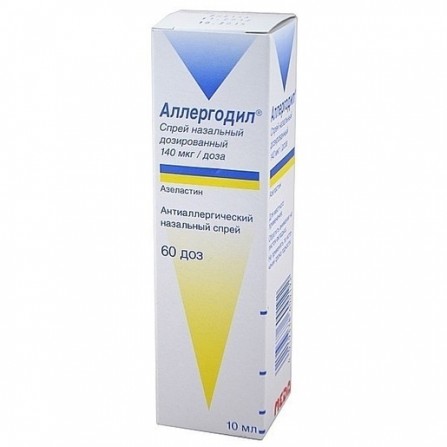Allergodil spray nasal 10mg
Condition: New product
1000 Items
Rating:
Be the first to write a review!

More info
Active ingredients
Azelastine
Release form
Spray
Composition
1 vial (10 ml) contains: active ingredient: azelastine hydrochloride 0.01 g; excipients: hypromellose, disodium edetate dihydrate, anhydrous citric acid, sodium hydrogen phosphate dodecahydrate, sodium chloride, purified water.
Pharmacological effect
Azelastine is a long-acting antiallergic agent derived from phthalazinone. Azelastine is a selective H1-histamine blocker, has antihistamine, antiallergic and membrane stabilizing effect, reduces capillary permeability and exudation, stabilizes the membrane of mast cells and prevents the release of biologically active substances (histamine, serotonin, leukotrienes, stimuli, activators, and stimulants). bronchospasm and contributing to the development of early and late stages of allergic reactions and inflammation. When applied topically, the systemic effect is minor. Intranasal administration reduces itching and nasal congestion, sneezing and rhinorrhea. The weakening of the symptoms of allergic rhinitis occurs from 15 minutes after application and lasts up to 12 hours or more. There is no clinically significant effect on QT (QTc) even with prolonged use of high doses of azelastine.
Pharmacokinetics
Bioavailability after intranasal use is about 40%. The maximum concentration (Cmax) in the blood after intranasal administration is achieved in 2-3 hours. When applied intranasally at the recommended daily dose of 1.1 mg, the equilibrium concentration in the blood is less than 1% of the dose (1 ng / ml). The concentration of the drug in the serum after intranasal use is 8 times lower than after ingestion. In patients with allergic rhinitis , the concentration in the blood is higher than in healthy ones. Other pharmacokinetic data are studied when taken orally. Communication with blood proteins is 80-90%. It is metabolized in the liver by oxidation with the participation of the cytochrome P450 system with the formation of an active metabolic Litas dezmetilazelastina. Excreted mainly by the kidneys in the form of inactive metabolites. The half-life (T1 / 2) of azelastine is about 20 hours, its active metabolite dezmetilazelastina is about 45 hours.
Indications
- Treatment of seasonal and year-round allergic rhinitis (incl.hay fever) and rhinoconjunctivitis. - Treatment of symptoms of vasomotor (year-round non-allergic) rhinitis, such as nasal congestion, rhinorrhea, sneezing, post-nasal syndrome.
Contraindications
- Hypersensitivity to azelastine and / or other components of the drug; - In allergic rhinitis and rhinoconjunctivitis - children up to 6 years; with vasomotor rhinitis - children up to 12 years.
Use during pregnancy and lactation
When testing doses many times exceeding the therapeutic range, no evidence of teratogenic effect was obtained in animals, but since there is no experience with azelastine in pregnant and lactating women, the use of azelastine nasal spray during pregnancy and during lactation is not recommended.
Dosage and administration
Intranasal. Allergic rhinitis and rhinoconjunctivitis In the absence of other recommendations to adults and children 6 years and older - one dose (140 mcg / 0.14 ml) in each nasal passage twice a day, in the morning and evening. If necessary, adults and children over 12 years old - two doses (280 mcg / 0.28 ml) in each nasal passage twice a day, morning and evening. Allergodil is used until symptoms cease and is suitable for long-term use, but not more than 6 months of continuous treatment. Vasomotor rhinitis Adults and children over 12 years old - two doses (280 mcg / 0,28 ml) in each nose A new course twice a day, in the morning and in the evening. Allergodil is used until symptoms stop and is suitable for continuous use, but not more than 8 weeks of continuous treatment. The volume of one injection (one dose) is 0.14 ml and contains 140 μg of the active substance. Order of application1 . Remove the protective cap2. Before the first use, press the sprayer 2 - 3 times.3. Depending on the dose administered, inject once or twice in each nasal passage, keeping your head straight. Put the protective cap back on.
Side effects
Rarely - a weak, transient irritation of the inflamed mucous membrane of the nose, manifested by burning, itching, sneezing, in rare cases of nose bleeding. As a result of the wrong method of administration, when the head is thrown back, a bitter taste in the mouth may occur, which in rare cases may cause nausea. Very rarely - allergic reactions (rash, pruritus, urticaria), weakness, dizziness (may be caused by the disease itself).
Overdose
Currently, cases of drug overdose with intranasal use are unknown.
Interaction with other drugs
When intranasal use of azelastine revealed no clinically significant interactions with other drugs.
special instructions
In some cases, the use of nasal spray reveals fatigue, varying severity and weakness, which can also be caused by the underlying disease. In these cases, it is not recommended to drive a car and work with dangerous machinery. Drinking alcohol can increase these effects.


